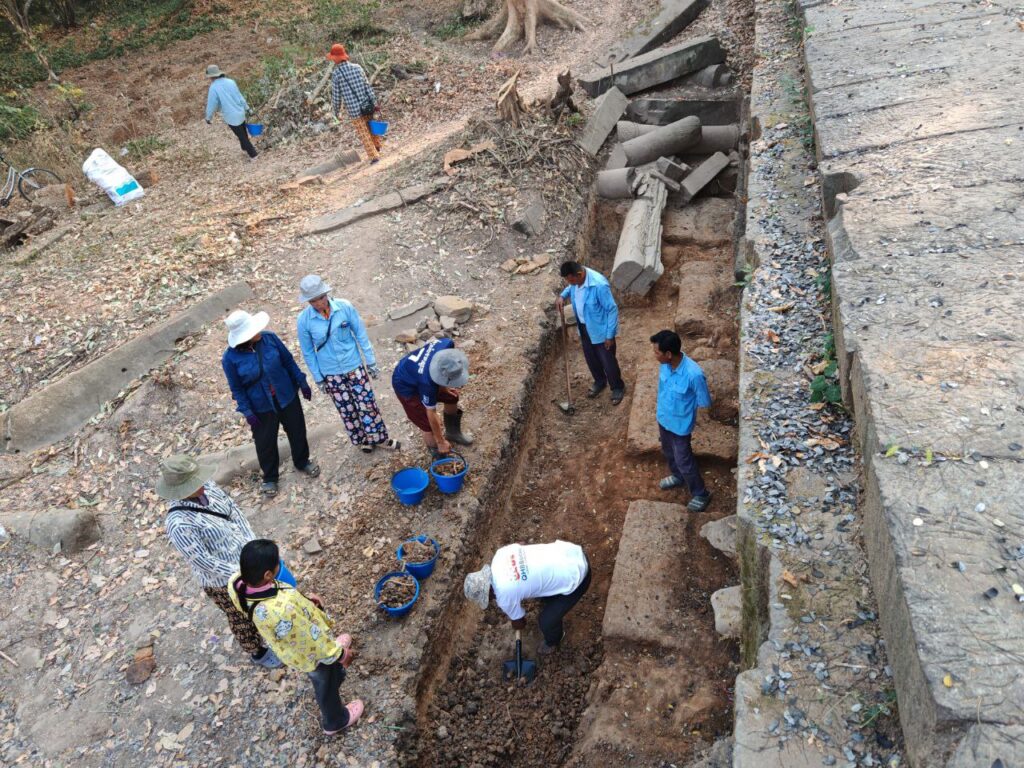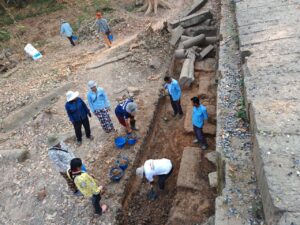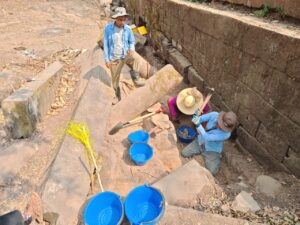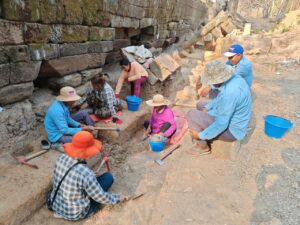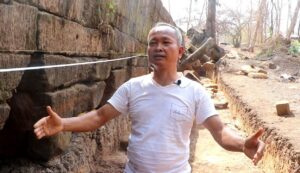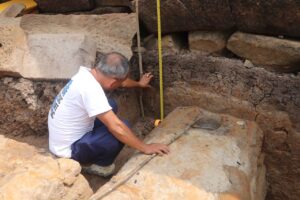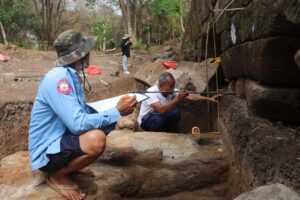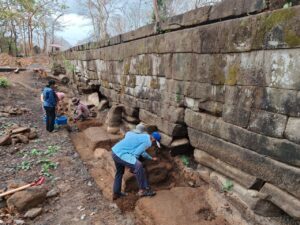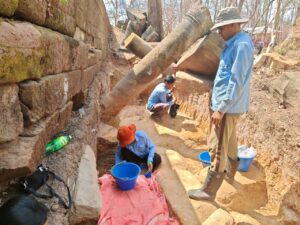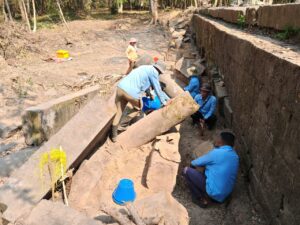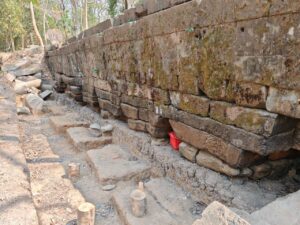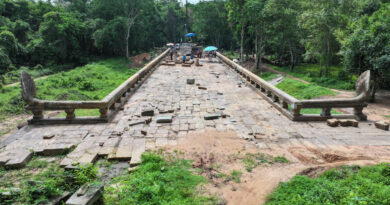ក្រុមអ្នកជំនាញរបស់អាជ្ញាធរជាតិអប្សរា ធ្វើកំណាយសង្គ្រោះនៅស្ពានហាលខាងលិចរបស់ប្រាសាទបេងមាលា ស្ថិតនៅភូមិបឹងមាលា ឃុំបឹងមាលា ស្រុកស្វាយលើ ខេត្តសៀមរាប។
ការធ្វើកំណាយសិក្សាស្រាវជ្រាវនេះ ជាគម្រោងរបស់អាជ្ញាធរជាតិអប្សរា ដើម្បីរៀបចំជួសជុល និងស្ដារប្រព័ន្ធផ្លូវទឹករបស់ស្ពានហាលខាងលិចនៃប្រាសាទបេងមាលា ឱ្យដំណើរការល្អឡើងវិញ ដើម្បីនាំយកទឹកតាមកសិន្ធុទៅបំពេញវាលផ្ទី ស្ថិតនៅខាងកើតប្រាសាទ(ជាសំណង់រក្សាទឹក សព្វថ្ងៃគេនិយមហៅ បារាយណ៍)។
លោក ខៀវ ច័ន្ទ បុរាណវិទូ ដែលគ្រប់គ្រងការដ្ឋាននៅប្រាសាទបេងមាលា បានឱ្យដឹងថា ការធ្វើកំណាយសង្គ្រោះនៅស្ពានហាលខាងលិចរបស់ប្រាសាទបេងមាលា ក្នុងបំណងស្វែងយល់ពីស្ថានភាពគ្រឹះ ស្ថានភាពបាតកសិន្ធុ និងដីកកក្រោមស្ពាន មុននឹងស្ដារដីកកនៅក្នុងរន្ធត្រដេវ និងកសិន្ធុចេញ ដើម្បីឱ្យទឹកបានហូរដូចដើមឡើងវិញ។
លោក ខៀវ ច័ន្ទ បានឱ្យដឹងថា គឺដើម្បីស្វែងយល់អំពីរចនាសម្ពន្ធស្ពាន និងការប្រើប្រាស់សម្ភារសំណង់ ថាតើដូចគ្នាទៅនឹងស្ពានហាលខាងកើតរបស់ប្រាសាទបេងមាលាដែរឬទេ? ម្យ៉ាងវិញទៀត កំណាយនេះ គឺដើម្បីជួយសង្គ្រោះថ្មសំណង់ជាច្រើនដូចជា ខ្លួននាគជាបង្កាន់ដៃស្ពាន ជើងសសរ និងធ្នឹមរបស់ស្ពានហាលខាងលិច ដែលបានរលុះធ្លាប់កប់ដីជាយូរឆ្នាំមកហើយនោះ យកទៅរៀបចំរក្សាទុកដាក់ឱ្យបានល្អ និងអាចជួសជុលឡើងវិញ ដើម្បីទុកប្រើប្រាស់មុននឹងយកទៅដាក់តាមទីតាំងដើមវិញ។
ក្នុងដំណើរការធ្វើកំណាយរយៈពេលជាង១ខែមកនេះ ក្រុមអ្នកជំនាញបានដឹងថា រចនាសម្ពន្ធ និងសម្ភារសំណង់របស់ស្ពានហាលខាងលិចនៃប្រាសាទបេងមាលា គឺធ្វើពីថ្មភក់ ហើយផ្លូវទឹកហូរក្រោមស្ពានហាលនេះ គ្មានកម្រាលធ្វើពីថ្មបាយក្រៀមទេ។ រចនាសម្ពន្ធរបស់ស្ពានហាលខាងលិចនេះ គឺខុសគ្នាពីរចនាសម្ពន្ធរបស់ស្ពានហាលខាងកើតប្រាសាទបេងមាលា ដែលរចនាសម្ពន្ធនោះមានកម្រាលក្រោមស្ពានជាពីរថ្មបាយក្រៀមមួយស្រាប់ក្រាលលើគ្រឹះខ្សាច់លាយថ្មភ្នំ៕
អត្ថបទ៖ ឆាយ ផាន់នី
រូបភាព៖ លោក យី សុថា,ក្រុមការងារកំណាយ
The APSARA National Authority is currently conducting archaeological excavations at the western causeway of Beng Mealea Temple, situated in Boeung Mealea Village, Siem Reap Province. This initiative is part of a project aimed at repairing and restoring the waterway system of the temple’s western causeway, ensuring its functionality to channel water from the moat to the eastern floodplain, which serves as a reservoir structure known locally as a baray.
According to Mr. Khieu Chan, an archaeologist involved in the project, the excavations focus on assessing the condition of the causeway’s foundation, the moat’s bottom, and the underlying soil. This information is crucial for restoring the water flow to its original state.
The excavation also aims to analyze the construction techniques and materials used for the western causeway, comparing them to those of the eastern causeway. Additionally, the team is working to recover various construction stones, including Naga balustrades, pillars, and beams that have been buried for years. These materials will be stored and repaired for future use in their original locations.
Over the course of more than a month of excavation, experts have discovered that the western causeway is primarily constructed from sandstone and lacks a paved surface beneath the water flow path. This structure differs from that of the eastern causeway, which features two paved surfaces supported by a foundation of sand mixed with mountain stones.
Article by Chhay Phanny
Photos by Yi Sotha, Excavation Team
Translation by Net Phirun
Translation by Net Phirun

